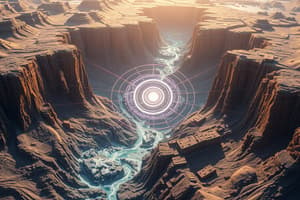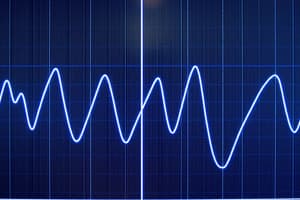Podcast
Questions and Answers
What is a significant building characteristic in seismic design?
What is a significant building characteristic in seismic design?
- Size
- Shape
- Color
- Period (correct)
What is a primary effect of earthquakes on the natural environment?
What is a primary effect of earthquakes on the natural environment?
- Liquefaction (correct)
- Utility lifeline disruptions
- Hazardous material spills
- Fires
Which system is considered a lifeline in mitigation plans?
Which system is considered a lifeline in mitigation plans?
- Communications systems (correct)
- Law enforcement agencies
- Emergency responders
- Ambulance services
What is a secondary consequence of earthquakes that must be considered?
What is a secondary consequence of earthquakes that must be considered?
What is the purpose of a diaphragm in seismic design?
What is the purpose of a diaphragm in seismic design?
What is the main focus of Unit 4?
What is the main focus of Unit 4?
What is a significant effect of earthquakes on the natural environment?
What is a significant effect of earthquakes on the natural environment?
What is the primary purpose of site investigation in seismic areas?
What is the primary purpose of site investigation in seismic areas?
What are the 'primary effects' of an earthquake?
What are the 'primary effects' of an earthquake?
What is a key factor in seismic design of buildings?
What is a key factor in seismic design of buildings?
What is a secondary consequence of earthquakes that must be considered?
What is a secondary consequence of earthquakes that must be considered?
What was the percentage of damage caused by ground motion in the 1906 San Francisco earthquake?
What was the percentage of damage caused by ground motion in the 1906 San Francisco earthquake?
What is the primary cause of damage to the built environment during an earthquake?
What is the primary cause of damage to the built environment during an earthquake?
What was the result of the ruptured gas lines in the 1906 San Francisco earthquake?
What was the result of the ruptured gas lines in the 1906 San Francisco earthquake?
What is the term used to describe the process of water-saturated, unconsolidated soil acting like a dense fluid during an earthquake?
What is the term used to describe the process of water-saturated, unconsolidated soil acting like a dense fluid during an earthquake?
What is a seismic safety measure that can be taken to prevent secondary effects of an earthquake?
What is a seismic safety measure that can be taken to prevent secondary effects of an earthquake?
How long did the fires burn in the 1906 San Francisco earthquake?
How long did the fires burn in the 1906 San Francisco earthquake?
What is an example of a secondary effect of an earthquake?
What is an example of a secondary effect of an earthquake?
Flashcards are hidden until you start studying
Study Notes
Mitigation Plans
- Mitigation plans should consider the following lifelines: Water and sewage systems, Electric power systems, Oil and natural gas systems, Communications systems, and Transportation systems
Earthquake Effects on Natural Environment
- Liquefaction: Strong ground motion can cause water-saturated, unconsolidated soil to act like a dense fluid
- Landslides: Earthquakes can trigger landslides
- Faults: Earthquakes can cause faults to rupture
- Tsunamis, flooding, and seiche: Earthquakes can trigger these events
Building Characteristics for Seismic Design
- Period and resonance: Building characteristics that affect seismic design
- Damping: Building characteristic that affects seismic design
- Ductility: Building characteristic that affects seismic design
- Stiffness: Building characteristic that affects seismic design
- Drift: Building characteristic that affects seismic design
- Building configuration: Building characteristic that affects seismic design
How Buildings Resist Earthquake Forces
- Diaphragms: Systems used to resist earthquake forces
- Horizontal bracing systems: Systems used to resist earthquake forces
- Moment-resistant systems: Systems used to resist earthquake forces
Secondary Consequences of Earthquakes
- Fires: Can be caused by ruptured gas lines and damaged fireplaces, flues, and stove pipes
- Hazardous material spills: Can be caused by ruptured pipes and containers
- Utility lifelines: Can be damaged or disrupted, leading to secondary consequences such as water main breaks and loss of power
Studying That Suits You
Use AI to generate personalized quizzes and flashcards to suit your learning preferences.




